Plant Information Resource Center
A Service Provided by Bohn's Farm and Greenhouses
Acanthus spinosusBear'S Breeches, Spiny
Upright spikes of purple and white flowers in early summer. Glossy, deeply lobed leaves with spiny margins form large clumps. Reliable and vigorous. Acanthus leaves have a classical appearance and were the source of the Corinthian leaf motif developed and used as a decoration in ancient Greek and Roman art and architecture.
[
More Info
]
|

|
Achillea 'Coronation Gold'Yarrow
Golden-yellow flower clusters are 3-4" wide on strong stems. Fernlike foliage is gray-green and wooly.
[
More Info
]
|

|
Achillea 'Moonshine'Yarrow
Clump-forming yarrow with flat-topped canary yellow flower clusters and bright silver, ferny foliage. Blooms over a long period. Will rebloom if cut back.
[
More Info
]
|

|
Achillea 'Terra Cotta'Yarrow
A multicolored selection, 'Terra Cotta' puts on a dazzling, everchanging show of salmon-peach, terra cotta orange, and pale yellow-orange flowers. When planted en masse, all three colors appear at the same time. They contrast nicely against the silver, ferny foliage.this variety has sturdy stems. This uniquely colored yarrow combines well with many other colors in the garden, especially purple and red.
[
More Info
]
|

|
Achillea millefoliumYarrow
Achillea millefolium, commonly called common yarrow, is a rhizomatous, spreading, upright to mat-forming perennial that is considered by many to be an aggressive weed. Common yarrow from Europe and Asia was originally introduced to America in colonial times, and has since naturalized throughout the U. S. primarily along roadsides, fields, waste areas and lawns. These species plants are noted for producing deeply-dissected, fern-like, aromatic, medium green foliage and tiny, long-lasting, white flowers that appear in dense, flattened, compound corymbs (to 2-4"across) throughout the summer on stems typically rising 2-3’ tall. Foliage has a strong, somewhat spicy aroma that persists when used in dried arrangements.
[
More Info
]
|

|
Achillea millefolium 'Oertel's Rose'Yarrow
Deep, rose-pink flower clusterare very well behaved in the garden, extremely drought tolerant, deer resistant, a Butterfly attractor, as well as a great cut flower. Grows best in sunny locations in well drained soils and blooms over a long period of time.
[
More Info
]
|

|
Achillea millefolium 'Paprika'Yarrow
Luscious apple-red and paprika colored flowers with sulphur yellow centers appear in flat clusters atop tall stems. Gray-green ferny foliage forms a compact, spreading mound.
[
More Info
]
|

|
Adiantum pedatumFern, Northern Maidenhair
Dainty bright green fronds on shiny black stems create a light, airy texture. Spreads by shallow rhizomes to form a dense groundcover . Thrives in moist, loose, rich soil.
[
More Info
]
|

|
Aegopodium podagraria 'Variegatum'Snow-On-The-Mountain
Green foliage with creamy white margins. Flowers are inconspicuous. A good ground cover but can be aggressive. Best if planted in a contained area.
[
More Info
]
|

|
Agastache 'Black Adder'Hyssop, Anise
Tall racemes of deep purple, nearly black buds open to light violet blue in midsummer and keep coming late into fall. A sterile form that won't turn weedy in the garden. Tolerates heat and drought.
[
More Info
]
|

|
Agastache 'Blue Fortune'Hyssop, Anise
Purple-blue flower spikes from mid- to late summer attract butterflies and hummingbirds. Foliage is very fragrant.
[
More Info
]
|

|
Agastache 'Purple Haze'Hyssop, Anise
Aromatic dark green, upright foliage with the scent of black licorice. Vibrant violet-purple flowers July through September. Heat and drought tolerant. Attracts songbirds. Zone 6.
[
More Info
]
|

|
Ajuga reptans 'Black Scallop'Bugleweed
Dark, dark burgundy, glossy foliage with roundly scalloped margins forms a low, dense ground cover. Short spikes of blue flowers in mid- to late spring.
[
More Info
]
|

|
Ajuga reptans 'Catlin's Giant'Bugleweed
[
More Info
]
|

|
Ajuga reptans 'Chocolate Chip'Bugleweed, Dwarf
Petite selection forms a dense mat of foliage. Narrow, shiny leaves are chocolate with burgundy highlights. Light blue flower spikes appear in April. Stunning show of color when planted in mass.
[
More Info
]
|

|
Alcea rosea 'Blacknight'Hollyhock
Deep black-purple, single flowers are produced on tall, sturdy stalks in midsummer. Spotlight Series is being introduced by Jelitto in 2010 with four single color strains including deep black-purple, red, yellow, and white.
Other than their fabulous blossoms, one of the best traits about this series is that the plants are truly perennialnot biennialand they bloom the first year from seed.
[
More Info
]
|

|
Alcea rosea 'Chater's Double Red'Hollyhock
This selection produces tall, sturdy spikes of red, ruffled, fully double flowers. They open from the bottom of the stalk to the top over a long period.
[
More Info
]
|

|
Alcea rosea 'Chater's Double Yellow'Hollyhock
This selection produces tall, sturdy spikes of yellow, ruffled, fully double flowers. They open from the bottom of the stalk to the top over a long period.
[
More Info
]
|

|
Alcea rosea 'Fiesta Time'Hollyhock
[
More Info
]
|

|
Alcea rosea 'Las Vegas'Hollyhock
Like the bright colorful lights of Las Vegas, this mixed color strain of fig leaf hollyhocks bears large, saucer-shaped flowers in unique shades of red, copper, chestnut brown, yellow, pink, and white over a long period beginning in early summer.
This hardy species of hollyhock has decorative lobed leaves that are borne all the way up the stems, leaving little bare stem at the base. ‘Las Vegas’ is a bit shorter than the species, standing about 5-6 feet tall in bloom.
The breeder, Jelitto, claims this new hybrid should live longer than the typical biennial hollyhocks. It is possibly hardier than zone 3.
Feel free to grow hollyhocks under Black Walnut trees; they are tolerant of the toxic juglone that is emitted through the trees' roots.
[
More Info
]
|

|
Alcea rosea 'Mars Magic'Hollyhock
Bright red, single flowers are produced on tall, sturdy stalks in midsummer. For over 18 years, Jelitto worked to develop a consistent strain of stable, straight color, single flowered Hollyhocks. The Alcea rosea Spotlight Series was introduced by Jelitto in 2010 with multiple single color strains including deep black-purple, red, pink, yellow, and white. Other than their fabulous blossoms, one of the best traits about this series is that the plants are truly perennial, not biennial.
Feel free to grow hollyhocks under Black Walnut trees; they are tolerant of the toxic juglone that is emitted through the trees' roots.
[
More Info
]
|

|
Alcea rosea 'PEACHES 'N DREAMS'Hollyhock
[
More Info
]
|

|
Alchemilla mollis 'Thriller'Lady'S Mantle
Excellent gray-green foliage with tiny, star-shaped, green-yellow blooms. Slightly larger than the species yet remains compact and well behaved.
[
More Info
]
|

|
Allium 'Lavender Bubbles'Allium
Lavender Bubbles has a darker purple flower and blooms even later than Millennium. This variety is not known to reseed. Highly resistant to deer and rabbits and mildew. Drought tolerant, long lived perennial that can grow in clay soil. Attracts butterflies.
[
More Info
]
|

|
Allium 'Medusa'Allium
This ornamental onion has snaky, twisty leaves that will remind you of the snake hair from the Medusa legend. ‘Medusa’ forms a low mound of grey-green, narrow foliage with leaves the twist slightly at the end. The nodding buds look like snakes at the tips of the stems, before they straighten to form 1.75-2" rounded clusters of light amethyst purple flowers. Similar in flower color and flower foliage to ‘Blue Eddy’, but in a much larger form.
Butterflies and honeybees adore the flowers' sweet nectar but deer and rabbits steer clear of this perennial beauty.
[
More Info
]
|
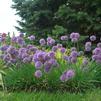
|
Allium 'Millenium'Allium
Long lasting rosy purple 2" globes bloom mid to late July, later than other Allium varieties. Compact variety. Bright green, clump-forming foliage is one of the earliest to emerge in spring. Highly resistant to deer and rabbits and mildew. Drought tolerant, long lived perennial. Attracts butterflies.
[
More Info
]
|

|
Allium 'Summer Peek-A-Boo'Allium
‘Summer Peek-a-Boo’s’ most charming attribute is how the flowers bloom just above its compact, short foliage. Round lavender-pink blooms on strong stems from June into early August. Butterflies and bees adore the flowers but deer and rabbits steer clear of this perennial beauty.
[
More Info
]
|
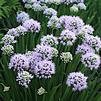
|
Allium angulosum 'Summer Beauty'Allium
Long lasting lavender-pink 2 globes bloom mid to late July, later than other Allium varieties. Bright green, clump-forming foliage is one of the earliest to emerge in spring. Highly resistant to deer and rabbits and mildew. Drought tolerant, long lived perennial. Attracts butterflies.
[
More Info
]
|

|
Allium giganteum 'Globemaster'Onion, Ornamental
'Globemaster' is a hybrid cross between A. christophii and A. macleanii. It is a bulbous perennial that is ornamentally grown for its spring bloom of spherical, deep lavender flower heads. Strap-shaped, gray-green, basal leaves form a clump of foliage in spring. As the leaves begin to wither in mid-spring, stout flowering stems rise to 20-30" tall topped with huge, globular, deep lavender to silver-purple flower heads (terminal umbels to 6-10" in diameter) packed with individual star-shaped florets which collectively display a metallic sheen. Flowers appear in an impressive, long-lasting, spring bloom (May in St. Louis) in which new florets continue to develop as the original ones fade. Flower heads dry after bloom and remain ornamental in the garden well into summer. Flowers generally lack fragrance.
[
More Info
]
|

|
Amorpha canescensLeadplant
Leadplant (Amorpha canescens) exhibits a unique display of both foliage and flowers. Spikes of iridescent purple flowers appear atop the delicate silver-gray foliage in the heat of mid-summer. Extremely long-lived, this is one of the few true shrubs of the prairie. Leadplant's deep taproot makes it extremely drought tolerant. Thrives in any well-drained soil.
[
More Info
]
|

|
Amorpha fruticosaFalse Indigo Bush
Long racemes of purple flower bloom in May and June. Foliage has shrub-like habit and pinnately compound leaves. Grows along stream banks and moist woods.
[
More Info
]
|
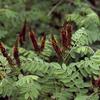
|
Amsonia hubrichtiiBlue Star, Narrow-Leaf
Pale blue star-like flowers in April and May. Narrow, feathery shrub-like foliage is green in summer, turning brilliant golden-yellow in the autumn. Excellent when massed.
[
More Info
]
|
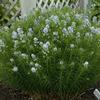
|
Amsonia illustrisBlue Star, Shining
Clusters of pale blue, star-like flowers grace a substantial mound of shiny, leathery leaves in May. Foliage often turns gold in fall. An easy-care native of the Ozarks.
[
More Info
]
|

|
Amsonia tabernaemontanaBlue Star
Loose clusters of lilac blue star-shaped flowers bloom in May. Willow like leaves turn a stunning shade of yellow-orange in autumn. Drought tolerant. Easy to grow. Midwest native.
[
More Info
]
|

|
Amsonia tabernaemontana 'Blue Ice'Blue Star
Plump navy blue buds open to vivid periwinkle blue, star-shaped flowers in Ma'y.considerably longer and stronger than the species with 5 weeks or more of color. More compact and darker blue flowers than the species. Willow like leaves turn a stunning shade of yellow in autumn.
[
More Info
]
|

|
Amsonia tabernaemontana 'Storm Cloud'Blue Star
Amsonia tabernaemontana, commonly called bluestar, is a Missouri native herbaceous perennial which occurs most frequently in rich, open woods and thickets in the southwestern part of the State. An erect, clump-forming plant which features terminal, pyramidal clusters of 3/4", soft light blue, star-like flowers in late spring atop erect, leafy stems growing 2-3' tall. Narrow, willow-shaped, dull green foliage may turn an attractive yellow in fall.
‘Storm Cloud’ features near black stems in spring clad with silver-veined dark green leaves. Leaves lighten to olive green by summer. Light periwinkle-blue, star-shaped flowers bloom abundantly from late spring to early summer, often with some rebloom thereafter. Plants typically grow to 24-30" tall spreading to as much as 42" wide.
[
More Info
]
|

|
Andropogon gerardiiGrass, Big Bluestem
King of native grasses! Blue-green foliage that can reach 8' tall forms distinctive seed heads in late summer. Nice red color in fall. Ideal as a background plant, specimen or in naturalized plantings.
[
More Info
]
|

|
Anemone 'Curtain Call Deep Rose'Anemone, Japanese
Beginning in late summer, this perennial produces dark rose flowers that are positioned just above a small mound of green foliage. The flower's fullness is due to a double row of petals. Compact, mounded habit, great for front of border. Moderate, but consistent moisture needs.
[
More Info
]
|
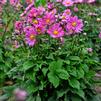
|
Anemone 'Fall in Love'Windflower
Semi-double pink flowers with yellow centers bring bright life to your fall garden. Slow, rhizomatous spreader.
[
More Info
]
|

|
Anemone 'Honorine Jobert'Windflower
Single white flowers with yellow center on tall graceful stems August through October. Dark green foliage forms attractive compact mound. Spreads by creeping rhizomes.
[
More Info
]
|

|
Anemone 'Pamina'Windflower
Japanese anemones are the perfect perennial to incorporate into your late summer and fall gardens. ‘Pamina’ comes into its prime just as other plants are beginning to retire for the season. From late summer into mid-fall, deep rosy pink 2.5" double flowers top tall, graceful stems which sway beautifully in the wind. Individual petals are elongated and daisy-like. Try planting Japanese anemones with other fall bloomers such as asters, snakeroot, and toad lilies.
[
More Info
]
|

|
Anemone 'Pocahontas'Windflower
Covered in double flowered, bubblegum pink blooms from mid to late summer! The seed heads look like fluffy cotton balls, standing atop strong stems to give interest to the garden from fall into winter. This vigorous, clumping selection is a delight in the garden or mixed container.
[
More Info
]
|

|
Anemone 'Whirlwind'Windflower
Semi-double pure white flowers are 4" across blooming September and October.
[
More Info
]
|

|
Anemone canadensisAnemone, Meadow
A strong growing plant that needs room to move. Clear white single flowers top out at 18" from mid spring to early summer. A robust and competitive native plant that brightens up woodland edges and shady corners of the garden.
[
More Info
]
|

|
Anemone hupehensis 'September Charm'Windflower
[
More Info
]
|

|
Anemone sylvestrisAnemone, Snowdrop
Spring blooming Anemone has pure white, fragrant flowers with yellow stamens. Blooms rise above foliage on sturdy stems in April. Interesting white, wooly seed heads follow flowers. Spreads by rhizomes.
[
More Info
]
|

|
Aquilegia 'Swan Pink & Yellow'Columbine
The mid-size Swan series known for large bi-color blooms in rich colors on vigorous plants. This variety has pink outer spurs with yellow inner petals.
[
More Info
]
|

|
Aquilegia 'Swan Violet & White'Columbine
Pure white center surrounded by dark violet, shiny petals and spurs. The name honors the memory of the victims of the Columbine High School tragedy in Colorado. Proceeds benefit organizations that promote diversity and tolerance in schools.
[
More Info
]
|

|
Aquilegia caerulea 'KIRIGAMI light blue & white'Columbine
First year flowering, upright stems, and upward-facing flowers. Flowers are a mix of light blue and white shades. Aquilegia is especially lovely when allowed to naturalize in shady, woodland borders. Excellent potential as cut flowers, lasting up to 2 weeks in a vase.
[
More Info
]
|

|
Aquilegia caerulea 'KIRIGAMI Red & White'Columbine
Upright, delicate foliage produces stunning red and white blooms, no cold treatment required.
[
More Info
]
|

|
Aquilegia caerulea 'KIRIGAMI Yellow'Columbine
Sweet, large upward facing yellow blooms with pale yellow spurs, no cold treatment required
[
More Info
]
|

|
Aquilegia caerulea 'Origami Yellow'Columbine
Long spurred yellow, upward facing blooms appear above upright silver gray foliage.
[
More Info
]
|

|
Aquilegia canadensisColumbine
Lots of red and yellow nodding flowers for many weeks from late April until mid June. A great source of early nectar for butterflies and hummingbirds. Found naturally on rocky ledges and wooded rocky slopes.
[
More Info
]
|

|
Aquilegia hybrida 'Earlybird Purple Blue'Columbine
Unique color combination, upward facing flowers on compact short stems
[
More Info
]
|

|
Aralia cordata 'Sun King'Spikenard
This deciduous perennial offers huge, compound foliage with leaflets to six inches, chartreuse-yellow in color, shading to pale lime, in contrast to its red-brown stems. A striking foliage plant for a cool, moist and shaded position rich loam. In late summer, tiny white flowers on radiating stems appear, followed by small purple (inedible) berries. Foliage and stems disappear for winter.
[
More Info
]
|

|
Armeria maritima 'Splendens'Thrift
Long-blooming, hot pink flowers on compact plants bloom late April through early June with grass-like foliage.
[
More Info
]
|
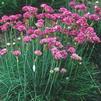
|
Armeria pseudarmeria 'Ballerina Lilac'Thrift
[
More Info
]
|

|
Aronia melanocarpaChokeberry, Black
[
More Info
]
|

|
Artemisia schmidtiana 'Powis Castle'Wormwood
Mounding, feathery, aromatic, silver foliage. Good filler plant. Drought tolerant. Foliage resists late season frost damage, thus maintaining garden interest into early winter.
[
More Info
]
|

|
Artemisia schmidtiana 'Silver Mound'Wormwood
Finely cut, soft, silver foliage forms a neat, rounded mound. Drought tolerant. Noninvasive variety. Insignificant flowers. Prefers poorly fertile soil. Cut back in late spring to avoid "melting out".
[
More Info
]
|

|
Aruncus dioicusGoat'S Beard
Large wands of frothy, creamy white flowers in May and June. Foliage is similar to astilbe but growth habit is shrub-like. A good native for woodland gardens.
[
More Info
]
|

|
Aruncus dioicus 'Chantilly Lace'Goat'S Beard
Goat's Beard loves part shade, and Chantilly Lace produces beautiful sprays of lacy, cream-colored flowers in late spring to early summer. Loads of inflorescences completely covers the deep green foliage. Goatsbeard is a great option to replace Astilbe in the garden if you're looking to incorporate more natives.
Aruncus doesn't like to be transplanted, so although it is a slow grower the first couple of years, plan on giving each plant plenty of room to fill in over time.
[
More Info
]
|

|
Aruncus dioicus 'Misty Lace'Goat'S Beard
[
More Info
]
|

|
Arundo donax 'Versicolor'Grass, Striped Giant Reed
A striking specimen plant with stiff, upright, variegated leaves. Plants resemble huge corn plants. Heat tolerant but needs moist, well-drained soil. Hardy with winter protection.
[
More Info
]
|

|
Asarum canadenseGinger, Wild
A deciduous ground cover with soft green, kidney-shaped leaves. Inconspicuous greenish brown flowers in April and May. Forms large colonies in cool, moist woodland areas. Very good deciduous ground cover for the shade garden.
[
More Info
]
|

|
Asclepias incarnataMilkweed, Swamp
Clusters of long-lasting vanilla-scented rose-pink flowers are butterfly magnets in July and August. A host plant for Monarch larvae, and a nectar plant for many butterfly species. Grows best in moist soils, but tolerates drier conditions.
[
More Info
]
|

|
Asclepias incarnata 'Cinderella'Milkweed, Swamp
Large 3-4" clusters of fragrant vanilla-scented rose-pink flowers in July and August over lush green foliage attract butterflies and beneficial insects from midsummer to early fall. Grows best in moist soils but tolerant of drier conditions.
[
More Info
]
|

|
Asclepias incarnata 'Ice Ballet'Milkweed, Swamp
Large clusters of long-lasting, small white flowers. Host plant for the monarch butterfly and a great nectar plant for many other butterfly species. As the common name suggests, this species grows best in moist soil but will tolerate drier conditions.
[
More Info
]
|

|
Asclepias purpurascensMilkweed, Purple
Asclepias purpurascens, Purple Milkweed looks similar to Common Milkweed (Asclepias syriaca), but the flower color is a rich red purple color compared to the soft gray-pink of Common Milkweed. There are usually one to three blooms that form near the ends of the stems in late spring, early summer.
The flower is held above the leaves on stems a bit longer then Common Milkweed’s and the umbel itself is stiff, and holds a nicely rounded form while that of Common will flop a bit. Blooms can last for about a month and if seed is not set it will occasionally re-bloom. The average height is around 3 feet but it will sometimes go to 4 feet. The flowers will attract a variety of nectar seeking insects from the very small to large Bumble Bees and of course Monarch Butterflies. The leaves are big, around 6-8 inches and they taper to a point at both ends. The mid-vein in the leaves is tinted with the same color as the flower.
Grow Asclepias purpurascens in a site that is well drained but has ample moisture. It seems to prefer a bit of shade but will do well in full sun if it gets deep, regular watering. This Milkweed will not spread aggressively like the Common does. The seed pods are smooth and a little more slender than those of Common Milkweed which has plump pods with a prickly surface.
[
More Info
]
|

|
Asclepias sullivantiiMilkweed, Sullivant'S
Similar to Common Milkweed but is less aggressive, has slightly smaller flowers, and an overall smooth appearance on the stem, leaves and seed pods. Visited by hummingbirds and a wide variety of bees and butterflies (including, of course, Monarchs), Prairie Milkweed is one of the plants favored by the larvae of the Milkweed Leaf-Miner fly, which bore holes in the leaves.
Bears a very fragrant pink flower, Prairie Milkweed makes a nice addition to any sunny medium to medium-moist garden. After just a few years the taproot will extend very deep, protecting the plant in times of drought, but also making it difficult to move so choose your spot wisely.
[
More Info
]
|

|
Asclepias syriacaMilkweed, Common
This native classic is best known as a food of larval monarch butterflies (along with its siblings A. incarnata and A. tuberosa). Robust and stoloniferous with deep pink clusters of fragrant flowers in June and July, followed by lovely pods of silky seeds in October.Monarch butterflies lay their eggs exclusively on Milkweed plants, making them the sole food source for their larvae. Once found in abundance in nearly every farm field, ditch, and disturbed site, Common Milkweed numbers have been in dramatic decline in recent years, due in part to suburban development and the increased efficiency of herbicides used in conjunction with herbicide-tolerant, genetically modified row crops. Common Milkweed is one of the easiest and fastest to establish of the Milkweeds. The large flower can vary in the color range from nearly white to deep pink-purple. The fragrance is very delicate and pleasing and numerous native pollinators will benefit during its long bloom time.
[
More Info
]
|
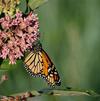
|
Asclepias tuberosaMilkweed, Butterfly
Abundance of bright orange flowers June through August. Host plant for the monarch butterfly and a superior nectar plant for many other butterfly species. Requires well-drained soil.
[
More Info
]
|

|
Asclepias tuberosa 'Hello Yellow'Milkweed, Butterfly
Clusters of vibrant yellow flowers bloom for many weeks. Host plant for the monarch butterfly and a superior nectar plant for many other butterfly species.
[
More Info
]
|

|
Asclepias verticillataMilkweed, Whorled
A widely adaptable and tough native is a deer-resistant food for larval butterflies. The fine-textured foliage provides a dark green backdrop for the clusters of white flowers that appear in June and July. Please note, Asclepias verticillata is highly toxic to livestock and horses - it should not be allowed to take root in pastures or hayfields. Found in dry fields, roadsides and shale barrens, you can see that it needs no coddling. Best located in a sunny dry spot, but will tolerate average to moist garden soil as well.
[
More Info
]
|

|
Asclepias viridisMilkweed, Spider
Green Milkweed shares with other Asclepias species its milky, irritating sap and strong attractiveness to Monarch butterflies and a host of other insects. Very tolerant of dry conditions, it is also called Green Antelopehorn. Green Milkweed features rose-white flowers surrounded by green that form in showy umbellated clusters, often one per plant. Its beauty and tendency to spread slightly make it a good garden choice. White crab spider lives on this plant.
[
More Info
]
|

|
Aster (syn Symphyotrichum) dumosus 'Wood's Light Blue'Aster
Light blue flowers for four to six weeks from late summer through early fall. Clean compact foliage is resistant to mildew and rust.
[
More Info
]
|

|
Aster (syn Symphyotrichum) dumosus 'Wood's Pink'Aster
Pale pink flowers with yellow centers for four to six weeks from late summer through early fall. Clean compact foliage is resistant to mildew and rust. Easy to grow. Tolerates clay soils.
[
More Info
]
|

|
Aster (syn Symphyotrichum) dumosus 'Wood's Purple'Aster
Purple-blue flowers with yellow centers for four to six weeks from late summer through early fall. Clean compact foliage is resistant to mildew and rust.
[
More Info
]
|

|
Aster (syn Symphyotrichum) ericodes 'Snow Flurry'Aster
Large white flower heads.
[
More Info
]
|

|
Aster (syn Symphyotrichum) ericoides 'Snow Flurry'Aster, Heath
A very low dense carpeting groundcover that is smothered with single white flowers with gold centers in September. A good strong grower and totally new look for Asters. Makes and excellent container plant.
[
More Info
]
|

|
Aster (syn Symphyotrichum) novae-angliaeAster, New England
Blooms August and September. AKA Symphyotrichum novae-angliae.
[
More Info
]
|

|
Aster (syn Symphyotrichum) novae-angliae 'Purple Dome'Aster, New England
Heavy blooming with deep purple flowers late July or early August and continuing through September and October. Densely compact mounded growth habit. While this plant may appear leggy in a container on the retail shelf, Purple Dome exhibits outstanding landscape performance and still offers the richest purple flower among all Asters. AKA Symphyotrichum novae-angliae.
[
More Info
]
|
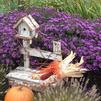
|
Aster (syn Symphyotrichum) oblongifoliusAster, Aromatic
A charming native with masses of blue-purple daisy like flowers blooming July through frost. Blue-green foliage forms tidy, compact, self-supporting mound and is aromatic when crushed. Neat, dome-shaped habit. AKA Symphyotrichum oblongifolium.
[
More Info
]
|

|
Aster (syn Symphyotrichum) oolentangiensisAster, Sky Blue
Dozens of blue flowers with yellow centers bloom in September and October. The foliage is blue-green and stems are dark. Butterflies love the nectar. AKA Symphyotrichum oolentangiense.
[
More Info
]
|

|
Astilbe 'Younique Carmine'Astilbe
The Younique series offer double blooms on compact foliage. Carmine offers medium to dark pink plumes.
[
More Info
]
|

|
Astilbe chinensis 'Maggie Daley'Astilbe, Chinese
Bright lavender-purple plumes are dense and fuzzy. Shiny dark green foliage is attractive even when the plant is not in bloom.
[
More Info
]
|

|
Astilbe chinensis 'Milk and Honey'Astilbe, Chinese
Creamy white plumes turn light pink as they age. Bushy foliage is somewhat marbled with green & silver when young. Vigorous, prolific bloomer; holds up under sun and drought. PPAF
[
More Info
]
|

|
Astilbe chinensis 'PURPLE CANDLES Purpurkerze'Astilbe, Chinese
A big, bold astilbe with dense, poker-like purple-red flower plumes in June and July. Very unique and useful tall Astilbe best placed in the back of the garden border. AKA Purple Candles.
[
More Info
]
|

|
Astilbe chinensis 'Visions'Astilbe, Chinese
Upright raspberry red plumes are sweetly scented. Deep bronze-green foliage. Tougher than arendsii types, A. chinensis grows best in moist soil but will tolerate temporary drought without burning. Blooms mid- to late-season.
[
More Info
]
|

|
Astilbe chinensis 'Visions in Pink'Astilbe, Chinese
Pink flowers on sturdy upright stems late May through early July. Shiny dark green foliage. Very robust and floriferous. More drought resistant than A. arendsii types. Late season bloomer.
[
More Info
]
|

|
Astilbe chinensis 'Visions in Red'Astilbe, Chinese
Deep purple-red flower buds open dark lavender on sturdy upright stems in June and July. Foliage is bronze-green. Very robust and floriferous. More drought resistant than A. arendsii types. Late season bloomer.
[
More Info
]
|

|
Astilbe chinensis 'Visions in White'Astilbe, Chinese
[
More Info
]
|
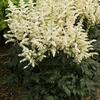
|
Astilbe chinensis var. pumilaAstilbe, Chinese
Lilac-pink fluffy flower plumes June through August on graceful, fernlike foliage mounds . Dwarf variety spreads to form an excellent ground cover. Needs consistent moisture for best performance.
[
More Info
]
|

|
Astilbe japonica 'Deutschland'Astilbe
Pure white, open lacy panicles in May and June above glossy deep green foliage. Early to midseason bloomer.
[
More Info
]
|

|
Astilbe japonica 'Elizabeth van Veen'Astilbe
Vibrant raspberry-purple plumes. Blooms in early summer. Mid-green foliage with a reddish tinge. A member of Astilbe japonica (Japanese Astilbe). A species characterized by an early bloom time and glossy green leaves often tinged with red. Flowers are produced in dense, pyramidal clusters. Spikes of graceful plumes, mostly erect but on some types arching. Flowers are effective in dried arrangements. Prefers a rich and moist soil in a shady location. Elisabeth van Veen features vibrant raspberry plumes on red stems. Red tinged glossy green foliage. One of the best varieties for container growing.
[
More Info
]
|

|
Astilbe japonica 'Montgomery'Astilbe
Dark magenta-red flower plumes rise above foliage in June. Glossy green, fern-like foliage, emerges bronze in spring. Stems are dark red. Thrives in moist conditions. Early to midseason bloomer.
[
More Info
]
|

|
Astilbe japonica 'Peach Blossom'Astilbe
Dense, pyramidal flower clusters are delicate peach with a hint of pink. Early blooming species blooms in mid May and early June. Fern-like mounds of glossy green foliage is sometimes tinged with red. Requires some sun to bloom.
[
More Info
]
|

|
Astilbe japonica 'Rheinland'Astilbe
Clear rose-pink flowers are held in large, diamond-shaped panicles. Very floriferous and vigorous. Large, mid-green leaves. One of the best early pink Astilbes.
[
More Info
]
|

|
Astilbe x arendsii 'Bridal Veil'Astilbe
Frothy profusion of pure white flowers. Midseason bloomer.
[
More Info
]
|

|
Astilbe x arendsii 'Fanal'Astilbe
Blood red flowers are presented in upright spires. Foliage is mahogany red in spring, turning green by summer. Very popular selection. Midseason bloomer.
[
More Info
]
|

|
Athyrium filix-feminaFern, Lady
Bright green, lacy fronds arise from creeping rhizomes. Clumps are dense and upright. Vigorous and easy to grow.
[
More Info
]
|

|
Athyrium filix-femina 'Lady in Red'Fern, Lady
Vibrant burgundy stems stand out against light green lacy fronds. Foliage is upright and arching. Naturalizes by creeping rhizomes.
[
More Info
]
|

|
Athyrium filix-femina 'Victoriae'Fern, Lady
Fringed leaflets form a criss-cross pattern creating a unique texture. Foliage is upright and arching. Tolerates drier conditions than most ferns. Vigorous grower.
[
More Info
]
|

|
Athyrium niponicum 'Ghost'Fern, Lady
Stunning silvery fronds are accented with dark maroon midribs. New growth emerges with a ghostly white hue maturing to silver. Striking upright, clump forming habit. A hybrid of A. n. Pictum (Japanese Painted Fern) and A. filix-femina (Lady Fern).
[
More Info
]
|

|
Athyrium niponicum 'Pictum'Fern, Japanese Painted
Showy silvery-grey fronds with purple-red veining and stems. Low, mounding habit. Brightens dark spots in shade border. Partners well with purple and red foliage plants. A tough fern for the Midwest. Easy to grow. 2001 Illinois Perennial Plant of the Year.
[
More Info
]
|

|
